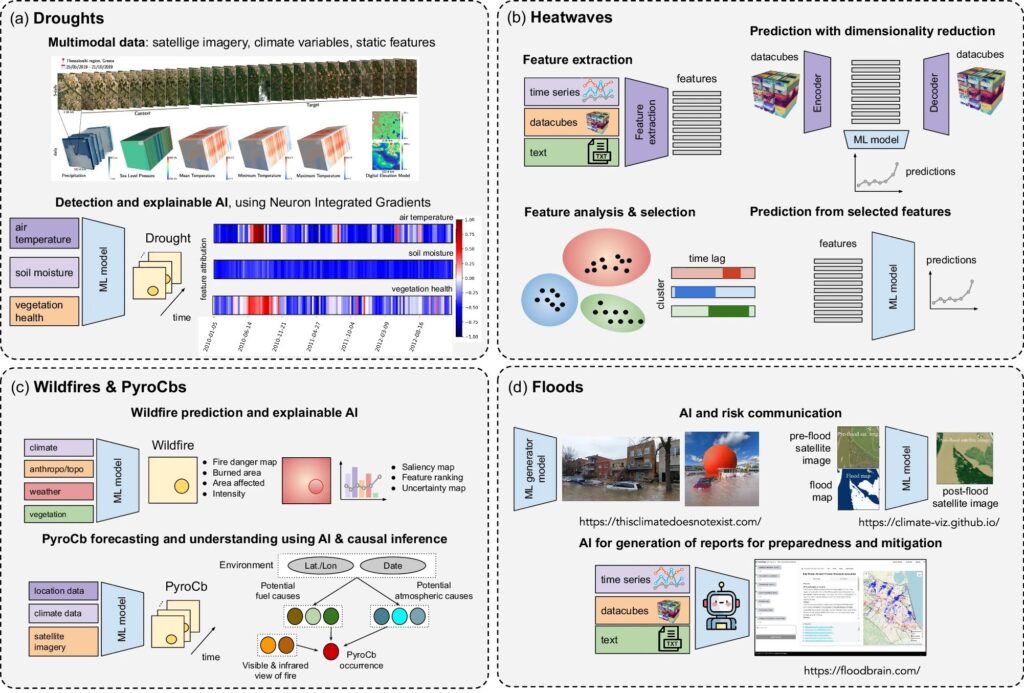PAPER: Artificial intelligence for modeling and understanding extreme weather and climate events
The paper is led by Gustau CAMPS-VALLS (Image Processing Laboratory, Universitat de València). It is an initiative from the ELLIS group.
Reference: Camps-Valls, G., Fernández-Torres, MÁ., Cohrs, KH. et al. Artificial intelligence for modeling and understanding extreme weather and climate events. Nat Commun 16, 1919 (2025). https://doi.org/10.1038/s41467-025-56573-8
This paper is a collaboration between the two sister projects XAIDA and CLINT but also a several Horizon Europe and H2020 projects as AI4PEX, ELIAS, MeDiTwin, DeepCube, the ERC USMILE and several national programmes in Spain and Germany.
This review explores how artificial intelligence (AI) can help analyse and model extreme events, such as natural disasters, and discusses the challenges and future directions in this field. AI faces challenges such as managing complex and evolving datasets, dealing with biases and defining what qualifies as ‘extreme’. Combining AI with traditional physical models presents both challenges and opportunities for improving accuracy. However, the complexity of AI, its lack of interpretability and difficulties in generalising across different situations pose trust issues.
Operational challenges include making AI results understandable to non-experts, addressing concerns about fairness and reliability, and ensuring ethical integration into decision-making. The lack of data, transparency and standardisation also hampers reproducibility and comparability. Overcoming these issues requires collaboration between AI researchers, climate scientists, policy makers and other experts.
Future improvements should focus on the development of trustworthy AI systems, the integration of real-time data and better evaluation methods to avoid over-fitting. Creating reference points, integrating expert knowledge and building scalable AI models will help AI adapt to unpredictable extreme events. Advanced language models can also improve risk communication. Ultimately, AI has the potential to significantly improve our ability to prepare for and respond to extreme events, benefiting society through innovation and research.
Key words:
- AI-driven detection, forecasting, impact assessment
- Explainability, causality & uncertainty in predictions
- Communicating risks, ensuring ethical AI, and operationalizing solutions
- Heatwaves, drought, floods, wildfire
Abstract:
‘In recent years, artificial intelligence (AI) has deeply impacted various fields, including Earth system sciences, by improving weather forecasting, model emulation, parameter estimation, and the prediction of extreme events. The latter comes with specific challenges, such as developing accurate predictors from noisy, heterogeneous, small sample sizes and data with limited annotations. This paper reviews how AI is being used to analyze extreme climate events (like floods, droughts, wildfires, and heatwaves), highlighting the importance of creating accurate, transparent, and reliable AI models. We discuss the hurdles of dealing with limited data, integrating real-time information, and deploying understandable models, all crucial steps for gaining stakeholder trust and meeting regulatory needs. We provide an overview of how AI can help identify and explain extreme events more effectively, improving disaster response and communication. We emphasize the need for collaboration across different fields to create AI solutions that are practical, understandable, and trustworthy to enhance disaster readiness and risk reduction.’

From the paper | Figure 3 – Summary of case studies using Artificial Intelligence (AI) to manage extreme events.
